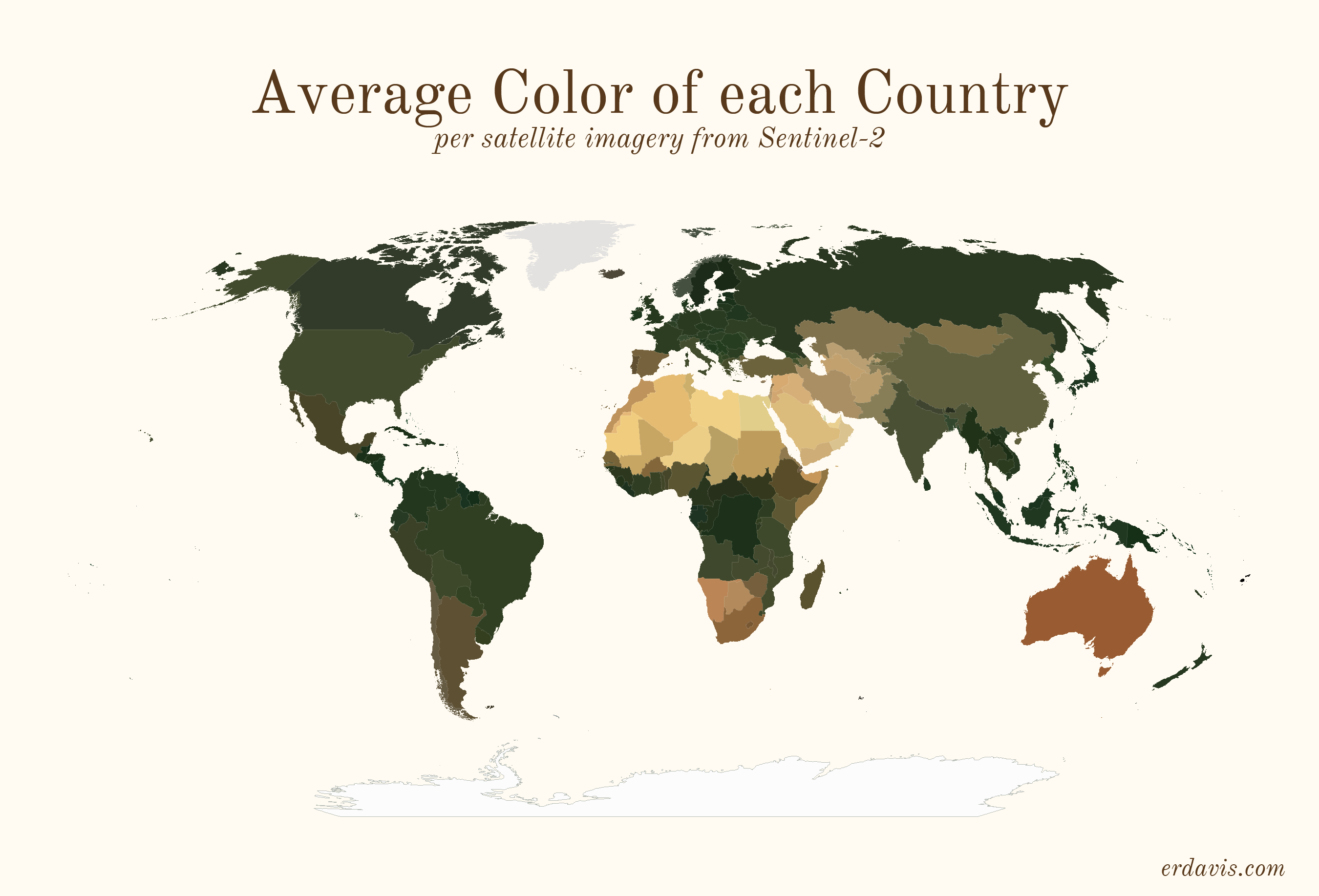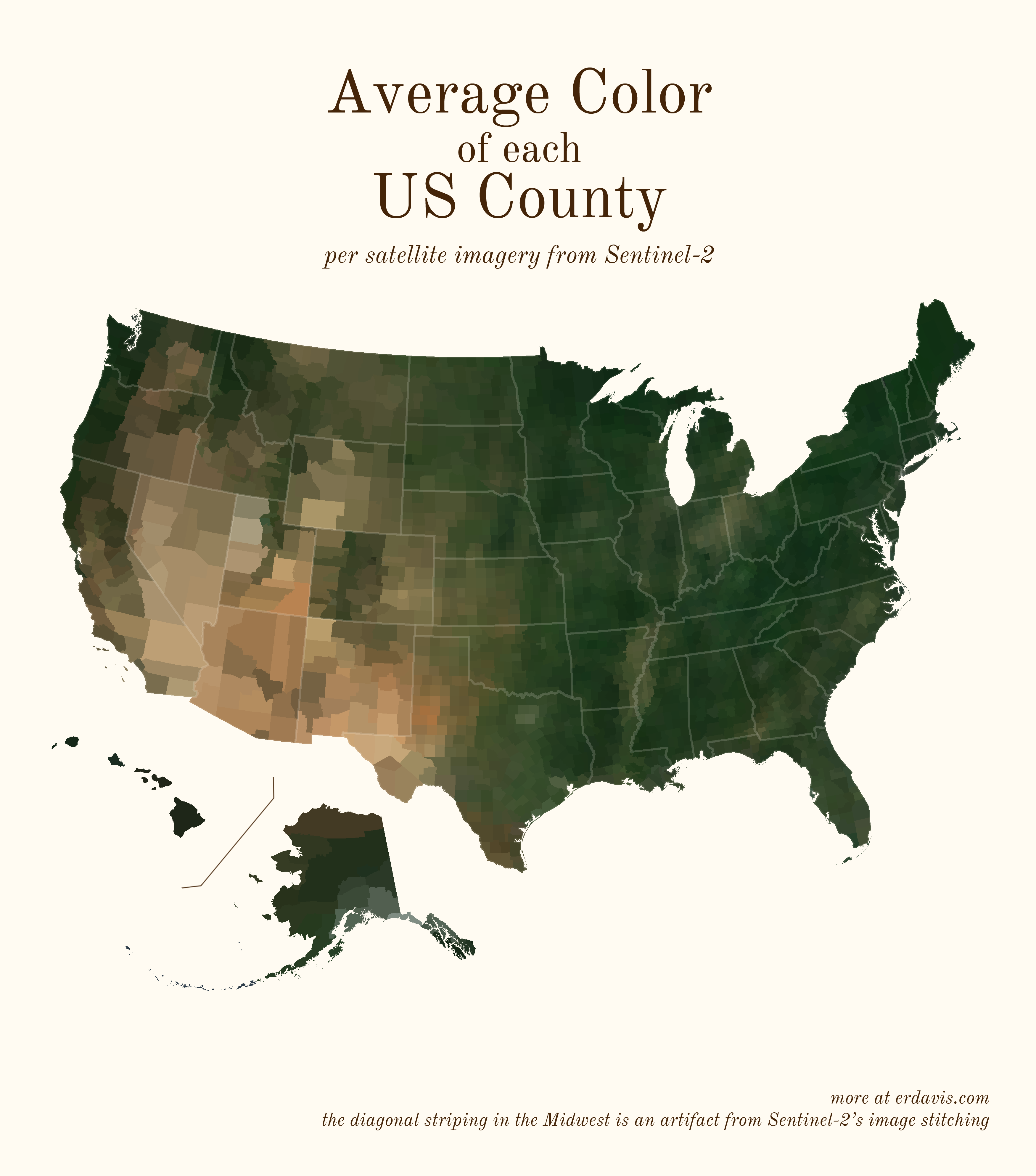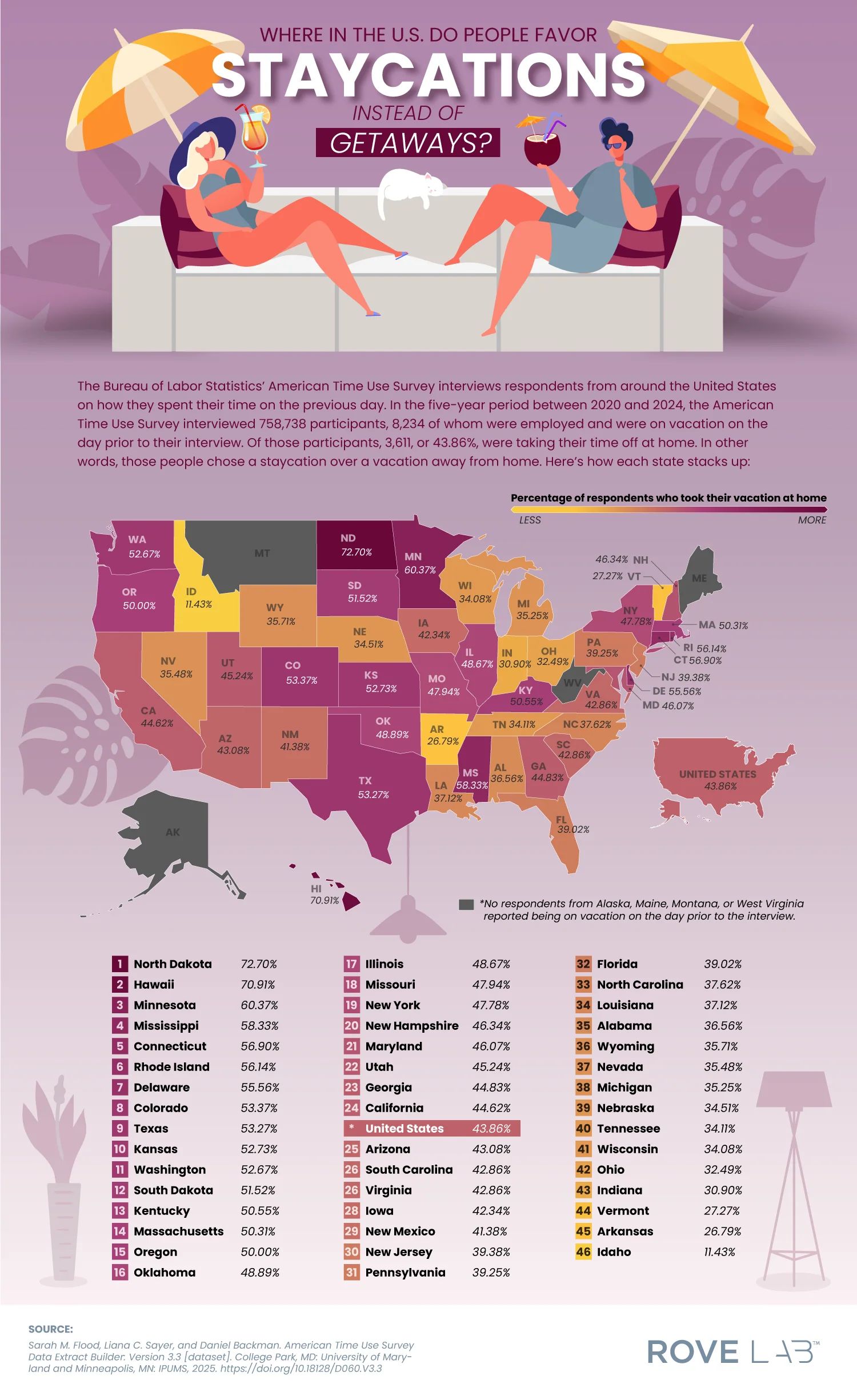Maps
The Average Terrain Colors of Countries Around the World
When you think about countries with an abundance of desert like Egypt, you generally think of yellow and orange sand colors. Likewise, countries with rainforests like Brazil most likely generate thoughts of deep greens. What color are the rest of the countries in the world?
Data visualization artist Erin Davis used satellite imagery from Sentinel-2 to illustrate the average color of the terrain in countries around the world.
Click below to zoom
The graphics use a choropleth map visualization to show the average color of the terrain in each country. Some countries, like snow-covered Greenland and Antarctica, are clearly colored how one would expect. Others take on a darker or more jewel-toned hue that reflects their unique landscapes.
The artist also illustrated the average color of each county in the United States for a more granular view of the country. The visualization highlights the forest-rich regions of the Northeast, Mid-Atlantic, and South East as well as well as the rugged physical geography of southwestern states like Arizona and New Mexico.
Click below to zoom
There are five major classes of land biomes in the world: forests, deserts, savannah, tundra, and grasslands. The nature of these biomes heavily impact the color of the areas picked up by satellite. These are the divisions of each biome around the world:
-
- Forests (40.1%): Forest biomes are populated by various species of deciduous and evergreen trees. This type of biome also includes rainforests, one of the most important forests in the world.
-
- Deserts (25.9%): Deserts are categorized as areas with very little rainfall. Daytime temperatures are typically high and nighttime temperatures are low.
-
- Savannah (16.7%): Savannah is tropical grasslands that are somewhere between lush tropical rainforests and desert regions. Their rainfalls typically occur during summer months, which means it evaporates quickly. These areas are prone to drought.
-
- Tundra (10.5%): The climate of the tundra is extreme cold. Temperatures in the winter often go below freezing and plant life is either nonexistent or dormant for much of the year.
-
- Grasslands (6.8%): Grasslands (also known as the Prairies in North America and the Pampas in South America) are temperate regions with warm summers and cool winters.
Business Visualizations
Ranking States by Workplace Cleanliness
The team at Stratus Building Solutions reveals which states have the cleanest and dirtiest workplaces in a new study. Cleanliness is often an overlooked but powerful influence on workers’ health, happiness, and productivity. People who work in an office spend many hours there and have a right to a clean, safe space to work, whether that’s at their desk, in the breakroom, or in the bathroom. The team’s study reveals that cleanliness depends on more than company policy and culture. It’s impacted by resources and state laws. While some states mandate rules that boost workers’ health and safety, other locations lack such protections and put workers at risk.
Click below to zoom.
The team created a scoring system based on some key criteria. First was the number of OSHA violations. OSHA is the Occupational Safety and Health Administration, which sets federal workplace safety standards, including sanitation standards. A state with a high number of OSHA sanitation violations is a clear sign of dirty workplaces. These violations could include unclean restrooms, inadequate waste disposal, or the presence of mold and bacteria. The team also examined the number of janitors per capita, population density, air pollution, and sick leave laws in each state.
The team found that these states were the cleanest with the highest scores:
- Nebraska
- Colorado
- North Dakota
- South Dakota
- Washington
- Missouri
- Montana
- Idaho
- Michigan
- New Mexico
The top scorers had low rates of OSHA violations, clean air, and high janitor-to-population ratios. State laws mandating sick leave also play a major role, as workers are more likely to stay home rather than bring germs to work.
These were the states that struggled the most with these standards:
- Tennessee
- North Carolina
- Mississippi
- Virginia
- Connecticut
- Oregon
- Nevada
- Rhode Island
- Alabama
- New Jersey
- Pennsylvania
Many of these states are on the dirty end of the spectrum, lacking paid sick leave. Tennessee, Mississippi, and North Carolina do not have laws on paid sick leave, which, when combined with the absence of handwashing stations and disinfecting services, makes the workplace a petri dish for germs. We also see heavily populated states like New York and New Jersey on the low end of the spectrum because more people means a greater challenge to clean up waste and keep germs at bay. High populations also mean bigger cities and more air pollution. We do see, however, that lower population density doesn’t necessarily mean cleaner workplaces, as Vermont was near the bottom of the list and has a small population.
Clean workplaces are healthy workplaces. Dust, germs, and air pollution lead to gastrointestinal and respiratory problems among workers. Simple precautions like regularly disinfecting surfaces, installing handwashing stations, and removing dust can boost the cleanliness of the office and the health of workers. Healthy workers mean better productivity and greater safety for all. Not only will a clean space improve worker experience, but OSHA violations can be very costly. The team’s study provides fascinating insights into what affects workplace cleanliness.
Maps
Study Reveals Top American Staycation Destinations
Many Americans find that staycations can be just as relaxing as a getaway vacation, but without the expense and hassle. For people who appreciate their home and community, a staycation is a perfect choice to recharge. The team at Rove Lab studied where staycations are the most popular and analyzed data to determine the ranking.
Click below to zoom.
Here are the top 10 places where staycations were most popular:
- North Dakota
- Hawaii
- Minnesota
- Mississippi
- Connecticut
- Rhode Island
- Delaware
- Colorado
- Texas
- Kansas
North Dakota comes first, and maybe that’s no surprise when 22 million visitors come to the state every year to explore national parks, world-class hiking, and other attractions. North Dakota is a peaceful, beautiful state where people can make the most out of a staycation. Hawaii comes in second place for similar reasons. Hawaii is a dream vacation destination for people all over the world. There’s no need to stray far when you can relax on some of the world’s best beaches in your own backyard. But there’s another factor to consider for Hawaiians. It’s an expensive state to travel in and out of. Most people need to fly to leave the islands, and that airfare is costly because of Hawaii’s isolated location.
There are many benefits to taking a staycation beyond saving money on transportation and lodging. A staycation offers the chance to sleep in, appreciate your community and home, and practice hobbies and self-care. You can also prioritize spending time with people you love and pets you can’t bring on vacation. There’s no need to pack, no reason to rush to the airport, and you can take a break that helps the environment by cutting the carbon emissions of travel.
There are so many benefits to taking a staycation. They reduce cortisol, the stress hormone, which is essential for our overall health and happiness. The only real benefit missing from a staycation is the mass of new opportunities. New experiences form new neural pathways in our brains, and that helps us see things from new perspectives, which can be a huge mood boost as well as enhancing problem-solving skills. There are ways to have new experiences on a staycation, too. You can refresh and redesign your living space for a new environment. You can treat your community like you’re a tourist there. Look for new places and experiences you’ve never had and indulge with excitement and an open mind.
Staycations remind us that we don’t have to run away to seek out rest. The best adventures can be quiet ones, like an afternoon drive to a new café or restaurant, a hike you’ve never been on, or enjoying the view from your own porch. It’s a call to reconnect with your own home and spend time exploring hidden gems in your local city. You can read, garden, or explore your surroundings. No matter what you choose, you’ll finish refreshed, and this Rove Lab study shows that many Americans have already experienced the benefits of a staycation.
Charts
These States Have the Cleanest Homes in the U.S.
The Oxi Fresh team has revealed the state of home cleanliness across the United States with a map ranking states by their score on the custom-made Oxi Fresh Home Cleanliness Index. Cleanliness can vary by cultural definitions and factors like busy lives can make our homes less clean than we would like. Studies have found that Americans spend about eight hours a month cleaning their homes. The team offers us a more in-depth look at the state of American cleanliness in their maps.
Click below to zoom.
The team formed the Home Cleanliness Index based on responses to survey questions. Five questions assessed how often residents perform specific cleaning tasks, like vacuuming, dusting, cleaning bathrooms, and changing bed sheets. They were also asked to rate their home’s cleanliness, the amount of clutter in their home, and how comfortable they would be with unexpected guests seeing their home in its current state. Lastly, the team asked whether residents in these states use a professional cleaning service.
These 10 states had the highest scores on the index:
- Wyoming
- Delaware
- Rhode Island
- Kansas
- Iowa
- Idaho
- Minnesota
- Arkansas
- Connecticut
- Tennessee
Wyoming residents are the cleanest, and they know it! 96% of them would be proud to have unexpected guests over who see the state of their home as it is. Wyoming homeowners deep-clean their carpets the most, mop the most, and change their bed linens the most often. It seems Wyoming homemakers prioritize cleaning and take great pride in their homes.
On the other side of the coin, these were the states with the lowest scores:
- New Hampshire
- North Carolina
- Maryland
- Maine
- Oregon
- Oklahoma
- Hawaii
- North Dakota
- Washington
- Utah
Utah had the lowest score overall at 69.76 out of 180 points. Utah residents reported the lowest scores for home cleanliness, but their data lends some credence to this. They dust, vacuum, and mop the least frequently. Utah may struggle with cleanliness due to its poor air quality. It has some of the worst air quality in the United States, with dust drifting in from the Great Salt Lake playa, as well as high emissions from gasoline vehicles and wood-burning stoves. Utah residents may feel they’re fighting a losing battle against dust, dirt, and grime and have lowered their standards.
There are many fun and interesting facts to glean from the team’s data. Delaware residents vacuum and mop the most, while Vermont residents maintain the cleanest kitchens with the highest number of kitchen counter wipe-downs. People in Iowa are the most likely to hire a professional cleaner. Arizona residents mop the least, maybe because the dry environment keeps out mud. Georgia and Arizona residents vacuum their carpets the least, but perhaps carpets and rugs aren’t as popular in these warm states. The data gathered here provide numerous opportunities to reflect on how various state factors may influence cleaning standards and norms.
-

 Business Visualizations1 year ago
Business Visualizations1 year agoEverything Owned by Apple
-

 Business Visualizations1 year ago
Business Visualizations1 year agoAmerica’s Most Valuable Companies Ranked by Profit per Employee
-

 Business Visualizations6 months ago
Business Visualizations6 months agoThe Biggest Employers by Industry
-
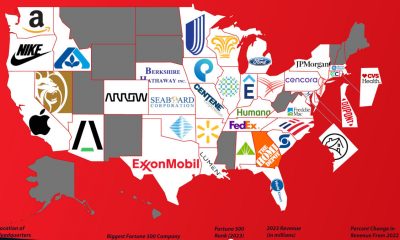
 Business Visualizations9 months ago
Business Visualizations9 months agoThe Biggest Fortune 500 Company in Every State
-
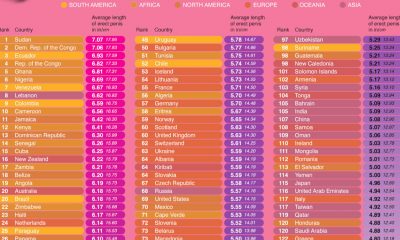
 Maps2 years ago
Maps2 years agoPenis Lengths Around the World
-
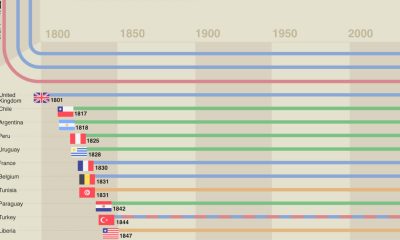
 Timelines2 years ago
Timelines2 years agoA History of the Oldest Flags in the World
-

 Business Visualizations2 years ago
Business Visualizations2 years agoAll The Brands Owned By PepsiCo
-
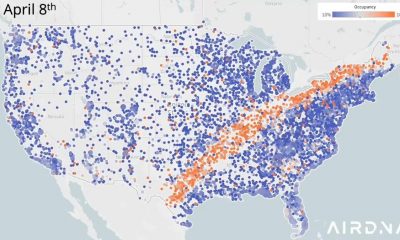
 Business Visualizations2 years ago
Business Visualizations2 years agoNew Animated Map Shows Airbnb’s Fully Booked Cities Along the 2024 Eclipse Path of Totality

